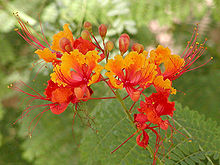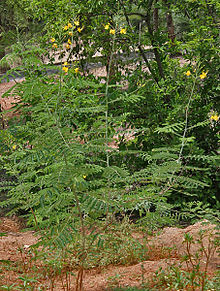- Caesalpinia pulcherrima
-
Caesalpinia pulcherrima 
Caesalpinia pulcherrima at the Desert Demonstration Garden in Las Vegas Scientific classification Kingdom: Plantae (unranked): Angiosperms (unranked): Eudicots (unranked): Rosids Order: Fabales Family: Fabaceae Genus: Caesalpinia Species: C. pulcherrima Binomial name Caesalpinia pulcherrima
(L.) Sw.Synonyms Poinciana pulcherrima L.[1]
 var. flava in Hyderabad, India.
var. flava in Hyderabad, India.
Caesalpinia pulcherrima is a species of flowering plant in the pea family, Fabaceae, that is native to the tropics and subtropics of the Americas. Its exact origin is unknown due to widespread cultivation.[1] Common names for this species include Poinciana, Peacock Flower, Red Bird of Paradise, Mexican Bird of Paradise, Dwarf Poinciana, Pride of Barbados, and flamboyan-de-jardin.
Contents
Description
It is a shrub growing to 3 m tall. The leaves are bipinnate, 20-40 cm long, bearing 3-10 pairs of pinnae, each with 6-10 pairs of leaflets 15-25 mm long and 10-15 mm broad. The flowers are borne in racemes up to 20 cm long, each flower with five yellow, orange or red petals. The fruit is a pod 6-12 cm long.
Symbolism
Red Bird of Paradise is the national flower of the Caribbean island of Barbados, and is depicted on the Queen's personal Barbadian flag.
Uses
Medicinal
Medicine men in the Amazon Rainforest have long known some of the medicinal uses for Caesalpinia pulcherrima, which is known as ayoowiri. Four grams from the root is also said to induce abortion in the first trimester of pregnancy.[2][3]
Ornamental
C. pulcherrima is the most widely cultivated species in the genus Caesalpinia. It is a striking ornamental plant, widely grown in domestic and public gardens and has a beautiful inflorescence in yellow, red and orange. Its small size and the fact that it tolerates pruning well allows it to be planted in groups to form a hedgerow; it can be also used to attract hummingbirds.[4]
Names
Common names for this species in other languages include
References
- ^ a b "Taxon: Caesalpinia pulcherrima (L.) Sw.". Germplasm Resources Information Network. United States Department of Agriculture. 2004-03-26. http://www.ars-grin.gov/cgi-bin/npgs/html/taxon.pl?8306. Retrieved 2010-12-03.
- ^ Counter, S. Allen (2006-07-24). "Amazon mystery: A medicine man understood the secrets of this plant long before we did. How?". The Boston Globe. http://www.boston.com/news/education/higher/articles/2006/07/24/amazing_mystery/.
- ^ Schiebinger, Londa L. (2004). Plants and empire: colonial bioprospecting in the Atlantic world. Cambridge, Mass.: Harvard University Press. p. 4. ISBN 978-0-674-01487-9.
- ^ Frisch, J.D. & Frisch, C.D., Aves Brasileiras e Plantas que as atraem, São Paulo: Dalgas Ecotec, 2005, 398, ISBN 978-85-85015-07-7
Categories:- Caesalpinia
- Plants described in 1791
- Flora of the Amazon
- Medicinal plants
- National symbols of Barbados
Wikimedia Foundation. 2010.
